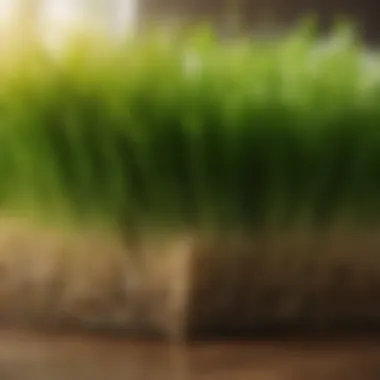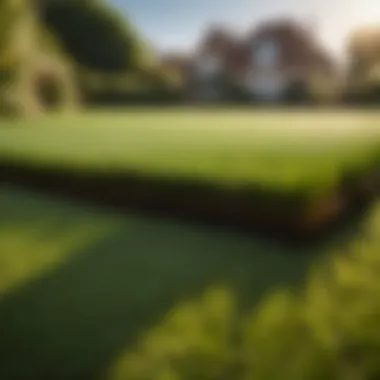Materials:
-
Dethatching machine: Purchase or rent a power dethatcher suitable for your lawn size. Make sure it has sharp blades for efficient thatch removal.
-
Lawn rake: You will need a sturdy lawn rake with metal tines to assist in removing loosened thatch and debris.
-
Plastic tarp: Use a large plastic tarp to collect and dispose of the removed thatch after dethatching.
-
Grass seed: Prepare grass seed suitable for your lawn type to overseed after thatching.
-
Lawn fertilizer: Have a high-quality lawn fertilizer on hand to nourish your lawn post-thatching.
-
Watering hose: Ensure you have a watering hose with a sprinkler attachment for proper watering post-thatching.
DIY Steps:
-
Planning: Assess your lawn's condition to determine if it needs dethatching. Look for signs such as excessive thatch buildup, compacted soil, or poor water absorption.
-
Preparation: Water your lawn thoroughly a day before dethatching to soften the soil. Clear the area of any debris or obstacles that may hinder the process.
-
Dethatching Process: Using the dethatching machine, set the blades at the appropriate depth and go over your lawn in overlapping rows. Make multiple passes if necessary to remove the thatch effectively.
-
Raking: Once dethatching is complete, use the lawn rake to gather the loosened thatch and debris. Rake in a crosshatch pattern to ensure thorough cleanup.
-
Overseeding: Spread grass seed evenly over the dethatched areas, focusing on sparse or damaged sections. Rake gently to cover the seeds lightly.
-
Fertilizing and Watering: Apply a suitable lawn fertilizer as per package instructions after overseeding. Water the lawn thoroughly to help the seed germinate and the fertilizer penetrate the soil.
Technical Aspects:
-
Tools: Ensure the dethatching machine is set at the correct depth to avoid damaging your lawn. Use the lawn rake gently to avoid uprooting healthy grass.
-
Timing: Dethatch cool-season grasses in early spring or fall and warm-season grasses in late spring. Avoid dethatching in the heat of summer.
-
Techniques: Overlap each pass of the dethatching machine to avoid missing any areas. Rake in different directions to ensure thorough cleanup.
DIY Project Process:


-
Detailed Installation Method: Dethatching should be done methodically, covering the entire lawn in a systematic pattern to ensure no area is missed.
-
Key Techniques and Timings: Take your time with dethatching to do it properly, as rushing can lead to incomplete thatch removal. Ensure adequate watering post-treatment.
-
Troubleshooting Tips: If your lawn shows signs of stress post-thatching, adjust watering frequency and consider applying a light topdressing of compost to aid recovery.
- Remember that proper thatching can transform your lawn's health and appearance, so dedicate time and effort to this essential task for a vibrant and lush green space.
Introduction


Thatching your lawn is an often underestimated yet crucial aspect of maintaining a lush and healthy green space. In this comprehensive guide, we delve into the art of thatching, providing you with a detailed roadmap to effectively care for your lawn. Understanding the significance of proper thatching techniques can significantly impact the overall health and appearance of your lawn. By exploring the signs indicating the need for thatching, the benefits it offers, and the step-by-step process involved, you will equip yourself with the knowledge to transform your lawn into a vibrant oasis.
When it comes to lawn care, thatching plays a pivotal role in fostering optimal growth conditions for your grass. By removing the layer of accumulated organic debris between the soil and the grass blades, you allow essential nutrients, air, and water to penetrate the root system more effectively. This process not only enhances the overall health of your lawn but also promotes robust growth and a visually appealing appearance. Recognizing the importance of proper thatching is the first step towards cultivating a verdant and thriving outdoor space.
Furthermore, this guide will walk you through the various considerations involved in planning and executing the thatching process. From identifying the ideal time to thatch based on seasonal variations to determining the thickness of thatch to make informed decisions about frequency, every aspect will be meticulously detailed. By following the insights provided in this guide, you will be empowered to make informed choices that optimize the results of your lawn care efforts.
In essence, this introduction sets the stage for a comprehensive exploration of the art of thatching in lawn care. By absorbing the information presented in this guide, you will not only enhance your understanding of the importance of thatching but also gain practical insights to elevate the health and aesthetics of your lawn to new heights.
Understanding Thatching


Thatching your lawn is a fundamental aspect of maintaining a healthy and vibrant green space, yet it is often overlooked in standard lawn care routines. This section delves into the importance of understanding thatching within the broader context of lawn maintenance, shedding light on specific elements, benefits, and considerations that underscore the significance of this practice.
What Is Thatching?
Thatching refers to the layer of dead grass, roots, and organic matter that accumulates on the surface of the soil beneath the active grass blades. It forms a dense mat that can prevent essential elements like water, air, and nutrients from reaching the soil and grassroots. This obstruction inhibits healthy grass growth and can lead to a range of issues, including lawn suffocation, poor drainage, and increased susceptibility to diseases and pests.
Signs Your Lawn Needs Thatching
Recognizing when your lawn requires thatching is crucial for preserving its health and appearance. Common signs that indicate the need for thatching include an excessively spongy lawn surface, an accumulation of more than half an inch of thatch, diminished water and nutrient penetration into the soil, and increased instances of disease or pest infestations. By being attentive to these signs, you can address thatch buildup proactively and maintain a thriving lawn ecosystem.
Benefits of Thatching
Thatching your lawn offers a myriad of benefits that are essential for promoting optimal grass growth and overall lawn health. Removing thatch allows for improved airflow, water penetration, and nutrient uptake into the soil, fostering robust root development and enhancing grass vigor. Additionally, thatch removal facilitates better seed-to-soil contact during overseeding efforts, promoting new grass growth and revitalizing sparse areas. Overall, regular thatching contributes to a lush, green lawn that is resilient against environmental stressors and maintains a visually appealing appearance.
Determining the Right Time for Thatching
Navigating the optimal timing for thatching your lawn is crucial to ensure its overall health and appearance. This section delves deep into the significant factors that influence the decision-making process regarding when to undertake this essential lawn care practice. Understanding the right time for thatching involves consideration of various elements that directly impact the effectiveness and results of the procedure. By determining the specific conditions and signals that indicate the necessity for thatching, homeowners can proactively address issues before they escalate, ultimately leading to a greener and more vibrant lawn.
Seasonal Considerations
Analyzing the seasonal variations is imperative when assessing the timing for thatching your lawn. Different seasons present unique challenges and requirements for lawn care, making it essential to align the thatching process with the most suitable time of the year. Factors such as temperature, rainfall, and grass growth patterns play a pivotal role in determining the ideal season for thatching. By considering the seasonal dynamics, homeowners can strategize and plan for optimal results and ensure the longevity and vitality of their lawn.
Assessing Thatch Thickness
The thickness of thatch buildup is a critical factor to evaluate when deciding on the timing for thatching your lawn. This subsection explores the methods and techniques for accurately assessing the thickness of thatch present in the lawn. By understanding the optimal thickness levels and the potential risks associated with excessive thatch accumulation, homeowners can make informed decisions about when to initiate the thatching process. Regularly monitoring and measuring the thatch thickness enables homeowners to intervene at the right time, preventing issues such as stunted grass growth and nutrient deficiencies.
Ideal Frequency of Thatching
Determining the ideal frequency for thatching your lawn involves a careful balance between regular maintenance and preserving the natural ecosystem of the grass. This section elaborates on the factors that influence the frequency of thatching, such as grass type, climate, and maintenance practices. By striking a harmonious balance and adhering to a systematic schedule for thatching, homeowners can promote healthy grass growth, enhance nutrient absorption, and create a visually appealing lawn landscape. Understanding the optimal frequency of thatching is essential for maintaining the overall health and longevity of the lawn.
Preparing for Thatching
Thatching your lawn is a vital part of maintaining a healthy and vibrant outdoor space. Before jumping into the actual thatching process, proper preparation is crucial to ensure successful results. This section will delve into the essential steps and considerations for preparing your lawn for thatching.
Tools and Equipment Needed
When it comes to getting your lawn ready for thatching, having the right tools and equipment is paramount. You will require a dethatching rake or power rake to effectively remove the thatch layer, which is essential for promoting healthy grass growth. Additionally, a lawn mower to cut the grass to an appropriate height before thatching is necessary. Other tools such as a leaf rake, lawn edger, and watering hose are also beneficial in preparing the lawn for thatching.
To enhance the efficiency of the thatching process, consider investing in a soil testing kit to assess the soil's pH level and nutrient content. This information can guide you in determining the necessary amendments to improve soil health and promote lush grass growth post-thatching. Ensuring your equipment is in optimal condition and readily available will streamline the preparatory phase and set the stage for a successful thatching endeavor.
Pre-Thatching Lawn Preparation
Apart from assembling the required tools and equipment, pre-thatching lawn preparation involves several key steps to lay the groundwork for a seamless thatching process. Begin by mowing the lawn at a lower setting than usual to expose the thatch layer and allow for easier removal. Clear any debris, like fallen leaves or branches, to ensure unobstructed access during thatching.
Moreover, watering the lawn thoroughly a day or two before thatching can soften the soil and make it easier to remove the thatch layer. This step is especially crucial in dry or compacted soil conditions to facilitate the thatch removal process. By preparing the lawn adequately ahead of time, you can optimize the effectiveness of the thatching process and set the stage for a revitalized and healthy lawn.
Executing the Thatching Process
Thatching your lawn involves a series of crucial steps that collectively contribute to the health and appearance of your lawn. Executing the thatching process is a fundamental stage that sets the foundation for a successful outcome. By following specific elements meticulously and understanding the benefits and considerations involved, you can ensure a vibrant and thriving green space.
Step 1: Thatch Removal
Thatch removal is a critical initial step in the thatching process. Thatch refers to the layer of dead grass, roots, and debris that accumulates between the soil and live grass blades. Excessive thatch can hinder water, air, and nutrient penetration, leading to a dull and unhealthy lawn. By meticulously removing thatch, you create space for new grass to grow and enable proper aeration and moisture absorption.
To effectively remove thatch, utilize a dethatching rake or a power dethatcher. Work systematically across your lawn, gently combing out the thatch to avoid damaging the underlying grass. Focus on areas with thicker thatch buildup, such as near trees or shrubs. Once you have completed the thatch removal process, gather and dispose of the extracted debris to prevent re-deposition.
Step 2: Raking and Cleanup
After successfully removing the thatch, the next step involves raking and cleanup to prepare the lawn for the subsequent processes. Raking helps disperse soil, smooth out uneven areas, and remove smaller thatch remnants that may remain post-dethatching. It also facilitates soil-to-seed contact, promoting better germination during overseeding.
Utilize a sturdy garden rake to gently rake the exposed soil, ensuring an even surface for overseeding. Remove any lingering thatch, rocks, or debris to create an optimal environment for new grass growth. Proper cleanup reduces the risk of thatch redistribution and promotes the absorption of water and nutrients by the soil, essential for healthy lawn development.
Step 3: Overseeding and Watering
Overseeding is a vital step in revitalizing your lawn post-thatching. Overseeding involves spreading grass seed over the existing turf to fill in sparse areas, enhance grass density, and introduce new grass varieties. This process helps maintain a lush and resilient lawn, particularly in regions prone to patchiness or bare spots.
Select a high-quality grass seed blend suitable for your lawn type and climate conditions. Evenly broadcast the seed using a spreader, focusing on areas with thin or bare grass coverage. After overseeding, water the lawn thoroughly but gently to ensure proper seed germination. Maintain consistent soil moisture without saturating the lawn to support healthy seed growth and establishment.
Post-Thatching Care
After successfully completing the thatching process, it is essential to focus on post-thatching care to ensure the health and vitality of your lawn. This crucial step plays a significant role in the recovery and rejuvenation of your grass after the rigorous thatch removal process.
Lawn Recovery Tips
During the immediate post-thatching period, it's vital to provide special attention and care to facilitate the recovery of your lawn. One important tip is to avoid heavy foot traffic on the freshly thatched area to prevent stressing the turf. Additionally, make sure to water your lawn adequately to promote new growth and enable the grass to establish itself firmly. Proper watering post-thatching is key to kickstarting the recovery process and fostering a lush, green lawn.
Implementing a fertilizer regimen tailored to the specific needs of your lawn can also aid in its recovery. Choosing a high-quality fertilizer rich in essential nutrients will nourish the grass and help it bounce back from the thatching process quickly. Keep a close eye on the lawn's progress and adjust the fertilizer application as needed based on growth and recovery indicators.
Maintenance Practices
Sustaining the health and beauty of your lawn post-thatching requires a commitment to regular maintenance practices. One crucial aspect of post-thatching maintenance is mowing the grass at the appropriate height to promote healthy growth and prevent thatch buildup. Adjust your lawn mower blades to the recommended height for your grass type, ensuring the blades are sharp to facilitate clean cuts and minimize stress on the turf.
Aeration is another essential maintenance practice that aids in soil compaction reduction, allowing for better air, water, and nutrient penetration to the grass roots. Aerating your lawn post-thatching will promote a robust root system and overall turf health. Consider scheduling aeration annually or as recommended based on your lawn's specific needs.
In addition to mowing and aeration, regular weed control measures are crucial to maintaining a pristine lawn post-thatching. Implementing a strategic weed control plan will help prevent weed encroachment and competition for resources, allowing your grass to thrive and flourish. Selective herbicides targeted at specific weed species can effectively manage weed infestations without harming your grass.
Conclusion
Thatching your lawn is a fundamental aspect of maintaining a healthy and vibrant green space, often overlooked but crucial for overall lawn health. This article has provided a comprehensive guide on the significance of thatching and the necessary steps to ensure the best results for your lawn. By understanding the signs indicating the need for thatching, housewives and homeowners can proactively address issues affecting the turf's health and appearance, leading to a more robust and aesthetically pleasing lawn. The benefits of proper thatching extend beyond mere cosmetic appeal; they include improved water infiltration, better air circulation, and enhanced nutrient absorption by the grass roots. Understanding the ideal frequency of thatching based on seasonal considerations and evaluating the thatch thickness are vital aspects that guide effective lawn care practices. By following the detailed process outlined in this guide, from preparing for thatching to post-thatching care and maintenance, individuals can transform their lawn into a lush, thriving landscape that enhances the overall ambiance of their home. In summary, mastering the art of thatching ensures a healthy lawn that not only looks beautiful but is also resilient and better equipped to withstand environmental stressors. This conclusion encapsulates the essence of the complete guide, emphasizing the importance of thatching in achieving and maintaining a lawn that excels in both health and aesthetics.





